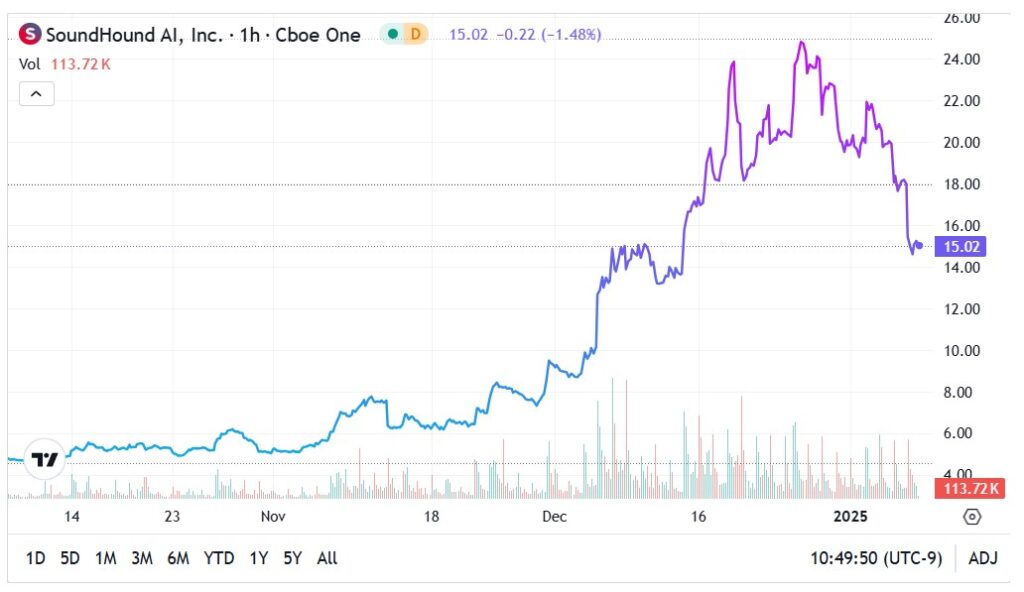While Nvidia Corp NVDA CEO Jensen Huang may be regarded as a hero within the broader technology ecosystem, the entrepreneur isn’t attracting much love for his straight talk.
With the practicality of innovations such as quantum computing potentially several years away, the blunt assessment triggered a sector-wide selloff, taking down conversational artificial intelligence specialist SoundHound AI SOUN.
To be fair, Huang — during Nvidia’s analyst day — expressed optimism about the future of quantum computing. Nevertheless, the executive mentioned that the innovation struggles with large data due to the underlying microwave-based communication. As such, he projected that practical applications may be 15 to 30 years away.
See Also: Fed Minutes Reveal Inflation Jitters, Policymakers Signal Slower Interest Rate Easing Path Ahead
Subsequently, such a timeline extends a competitive runway for SoundHound’s rivals, which may have contributed to the volatility in SOUN stock. While SoundHound isn’t directly tied to quantum computers, the general concern is that optimism for emerging technologies may have accelerated too quickly.
On a financial note, there’s also the matter of valuation. While SoundHound generally beats analysts’ earnings expectations, the company continues to post losses. True, the tech specialist enjoys strong revenue growth. However, with shares priced at around 82 times sales, SoundHound stock commands an ultra-rich premium.
As a prior Options Corner article alluded to, valuation doesn’t matter — until it does.
Statistical Trends Urge Against A Directional Bet
Despite the fallout in SoundHound stock, extreme value hunters may be tempted to buy the dip. Because experts agree that quantum computing and other advanced solutions have a bright future, it makes sense to be greedy during periods of extreme fear. However, the empirical data presents a more nuanced take.
In the past 141 weeks, there have been 34 instances when SoundHound lost 10% of value or more within a one-week period (Monday’s open to Friday’s close). Out of this bucket, only 18 instances (or 52.94% of the time) resulted in SoundHound delivering a positive return four weeks out.
Currently, trading activity indicates that SoundHound is on pace to post a loss between 20% to 30% for the business week ending Jan. 10. Statistically, 20% or worse weekly losses yield a 46.15% likelihood that the equity will be in positive territory four weeks out. For 30% or worse, the success ratio drops to 40%.

Stated differently, there’s no indication that traders buy extreme dips in SoundHound stock. Therefore, directional wagers are risky. That said, what is more certain is the magnitude of the response.
Overall, whenever SoundHound suffers a weekly double-digit percentage loss, investors can expect an average positive return of 37.1% and an average loss of 25.8% four weeks out. For losses that specifically land between 20% and 30%, investors may expect an average positive return of 18.55% and an average loss of 24.32%.
Charting Out a Long Iron Condor
With such a wide range of potential pricing outcomes, astute traders may opt for a special multi-leg options strategy called the long iron condor. Structured as a combination of a bull call spread and bear put spread, the transaction speculates that the underlying security will see a rise in implied volatility. In other words, it doesn’t matter where SOUN stock goes, so long as it hits either the upside or downside profitability target.
In a long iron condor, the above targets are represented by the outermost strike prices (i.e. the lowest strike price represents the short strike target of the bear put spread and the highest strike price represents the short strike target of the bull call spread).
Based on the empirical data mentioned earlier, traders may reasonably anticipate about a 25% decline in SoundHound stock four weeks from this Friday’s close. For the positive scenario, the upside may range between 19% to 37%.
Assuming a closing price of $15, SoundHound may land between $11.25 and $20.55 by the options chain expiring Feb. 7.
If so, the 12P | 13P || 17C | 18C long iron condor (or the combo of the 12/13 bear put spread and 17/18 bull call spread) would be narrow enough to likely trigger a profitable outcome. However, the maximum payout for this trade presently sits at only 20%.
Assuming a more robust positive response, aggressive traders may consider the 12P | 14P || 20C | 22C long iron condor, which bumps the max payout to 49%. However, wider condors are obviously less likely to trigger their profitability targets, making them increasingly speculative.
Now Read:
Image: Shutterstock
© 2025 Benzinga.com. Benzinga does not provide investment advice. All rights reserved.
